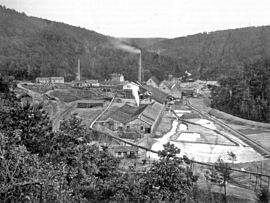Bliesenbach mine
| Bliesenbach mine | |||
|---|---|---|---|
| General information about the mine | |||
| General view of the operating facilities of the Bliesenbach mine around 1900 | |||
| Mining technology | Civil engineering | ||
| Information about the mining company | |||
| Start of operation | 1854 | ||
| End of operation | 1926 | ||
| Funded raw materials | |||
| Degradation of | Zinc , lead | ||
| Geographical location | |||
| Coordinates | 50 ° 58 '31.1 " N , 7 ° 23' 31.3" E | ||
|
|||
| Location | Loop | ||
| local community | Engelskirchen | ||
| country | State of North Rhine-Westphalia | ||
| Country | Germany | ||
| District | Bensberg ore district | ||
The Bliesenbach mine was a non-ferrous metal ore mine in the Bensberg ore district in the Loope district of Engelskirchen .
history
Antiquity
As early as around 20 AD, based on Roman pottery finds, mining activity can be assumed.
middle Ages
Mining took place on the Bliesenbach mine as early as the 13th century. The miners went up to 70 meters below the bottom of the tunnel and extracted the ores through a vertical shaft . Toughness from this period was found in an old man that is now kept in the German Mining Museum in Bochum . After that, the company was idle for centuries.
Modern times
Since 1821 there have been isolated experimental work. Unmanageable water inflows did not allow any further work between 1845 and 1847. Between 1850 and 1856 exploration work and excavation took place over a 190 meter long tunnel . At the same time, the piles of medieval mining were worked through, because they still contained large amounts of zinc ore , the smelting of which had only been brought to industrial maturity since the middle of the 19th century.
On the hillside, it came in 1852 to the workover of an old shaft in the area of medieval Pingenzugs . At the same time, a tunnel was driven from the bottom of the valley onto the shaft. Thus the Prussian mining authorities could face the success can be proven the deposit, followed in September 1854, the ceremony took place the mine.
Operation and facilities
Since 1885 the deposit had been mined to such an extent that regular mining with significant production volumes developed. In 1896 the workforce was 580 people. Around two thirds of them worked as a tuscher on site or as a tugboat underground . Since 1896 there was a horse-drawn tramway , with the help of which the mined ore was transported to Ehreshoven station for loading onto the railway . In 1897 a so-called cruet was built in which 80 to 100 people could sleep and / or be fed.
Since 1919 the AG for mining, lead and zinc production in Stolberg was the new operator of the mine. The greatest depth was reached at 522 meters. In 1926 operations were stopped.
Pictures from the Bliesenbach mine today
Deep pinging of the Kunigunde shaft with a piece of the foundation of the shaft system
literature
- Rainer Slotta : Technical monuments in the Federal Republic of Germany 4 / I , published by the German Mining Museum Bochum 1983, p. 609 ff. ISBN 3-921533-25-2
- Alfred Nehls: All wealth lay in the earth, The history of mining in the Oberbergischer Kreis , Verlag Gronenberg, Gummersbach 1993, ISBN 3-88265-180-6
Individual evidence
- ↑ a b c d Heinrich and Karl-Heinz Lüdenbach: Grube Silberkaule , in: Loope, a home book , published by Bürger- und Heimatverein Loope eV, Loope 2012, pp. 171 ff. ISBN 978-3-87314-473-6
- ↑ History Association Rösrath - Michael Gechter: Mining archeology in the Bergisches Land ( memento of March 3, 2016 in the Internet Archive ) accessed on December 3, 2015
- ↑ Gerd Weisgerber : Medieval mining finds from the Bliesenbach mine in the Oberbergischer Kreis , in: Der Anschnitt , year 48, 1996, pp. 2-18.
- ^ H. Stadler: data collection for a PB-Zn monograph by Berg. Landes , Geographisches Landesamt NRW, Krefeld undated, p. 15. f.
Web links
- Geocaching Grube Bliesenbach (Bergische Geschichte) accessed on September 21, 2014










